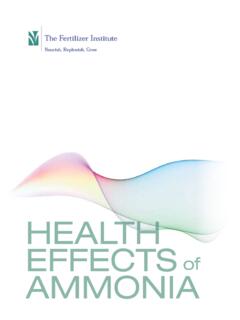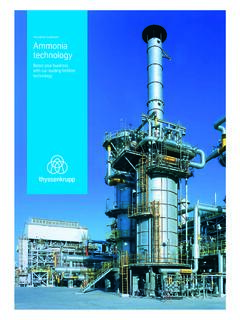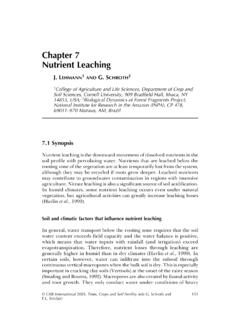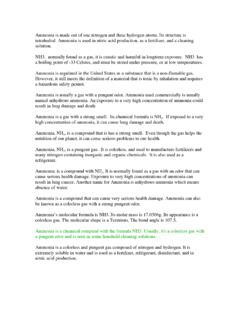Transcription of Can I Use this Fertilizer on My Organic Farm? Brian Baker
1 Can I Use this Fertilizer on My Organic farm ? Brian Baker Overview Organic farming relies primarily on the cycling of Organic matter to maintain soil fertility. The maxim to feed the soil to feed the plant' summarizes the Organic approach. Compost, cover crops, plant by-products, animal manure, and other biological materials form the bulk of what is applied to Organic fields for fertility. Organic farmers are also permitted to supplement the addition of Organic matter with the use of other natural products, such as mined minerals. The US Department of Agriculture's National Organic Program (NOP) rule [7 CFR 205] establishes the standard for agricultural products that can be labeled as Organic .' Most synthetic fertilizers are prohibited by this standard [7 CFR (a)], with a few specific exceptions found on the National List [7 CFR (j)]. The standard requires Organic producers to manage soil fertility and crop nutrients in a way that maintains or improves soil Organic matter content [7 CFR (a)].
2 this objective is achieved through crop rotations, growing cover crops and the application of plant and animal materials. Nutrients harvested are expected to be replaced by the recycling of Organic matter. However, the applications must be made in a way that does not result in the contamination of crops, soil or water by plants, nutrients, heavy metals, or materials that are otherwise prohibited for Organic production. Any Fertilizer or soil amendment to be used on certified Organic land must be included in the Organic System Plan (OSP) [7 CFR (a)(2)]. Before any farming input can be applied, the USDA Accredited Certifying Agent (ACA) must approve the OSP [7 CFR. (a)]. Animal manure that is composted or otherwise effectively treated to reduce pathogens may be applied without restriction to crops grown for human consumption. Raw animal manure is subject to an interval between application and harvest of crops for human consumption.
3 Crops that are in contact with the soil, such as carrots, potatoes, spinach and lettuce are subject to an interval of 120 days. Crops not in contact with the soil, such as corn, beans, and fruit, are subject to an interval of 90 days [7 CFR (c)(1)]. Composting is defined in the regulation based on the carbon-to-nitrogen (C:N) ratio, temperatures reached, and duration. The initial C:N ratio must be between 25:1 and 40:1. Temperatures must reach between 131 F (55 C) and 170 F (77 C). In an in-vessel or static aerated pile system, these temperatures must be maintained for at least three days. Windrow systems must meet these requirements for 15 days and the piles must be turned a minimum of five times [7 CFR (c)(2)]. Manure may be composted by other means or heat-treated to reduce pathogens. If the ACA can be shown that a treatment has a comparable reduction in pathogens to composting, then crops Page 1 of 5.
4 Can I Use this Fertilizer on My Organic farm ? may be harvested without the pre-harvest interval. Such processed manures are recommended to be incorporated in the soil so as not to reinfect crops grown for human consumption with food borne pathogens. Sewage sludge is categorically prohibited [7 CFR (g)]. Buyer Beware With the growth in Organic farming, the number of packaged fertilizers marketed to Organic farmers has also grown. Fertilizer labeling laws are enacted state-by-state in the United States. The regulators of Fertilizer labeling laws are organized through the Association of American Plant Food Control Officials (AAPFCO). Most states follow the AAPFCO model bill, which defines Organic Fertilizer ' as [a] material containing carbon and one or more elements other than hydrogen and oxygen essential for plant growth' (AAPFCO, 2008). this definition permits fertilizers to be labeled as Organic ' even if they do not necessarily comply with the NOP.
5 Standards to produce Organic food. As a result, sewage sludge, urea and blended fertilizers that contain Organic matter and a variety of synthetic fertilizers that contain some carbon may bear the Organic ' label but could result in the loss of the NOP certification of an Organic field for three years if applied. There is a tentative definition for Organic input' that more closely follows the NOP standard. However, that tentative definition has not yet been adopted by most states, coordination of state officials with USDA and ACAs will be a challenge, and the other conflicting uses of the word Organic ' on fertilizers are expected to continue to cause confusion for certified Organic farmers. Know What is In the Product When deciding whether to apply a Fertilizer to a field, it makes sense to first know the composition of the product. The label should contain complete information on all of the ingredients, but not all Fertilizer labels fully disclose all the ingredients.
6 In general, ingredients of plant or animal origin, such as alfalfa meal or feather meal, should be identified in plain language. Some familiar ingredients may require additional information. For example, compost made using plant and animal materials and other natural ingredients would be acceptable. However compost that is made from sewage sludge or fortified with synthetic fertilizers would be prohibited. Similarly, the presence of various chemical fertilizers , particularly macronutrient nitrogen, phosphate or potash sources on the label would indicate that the product is prohibited for use in Organic production. These include all ammonia fertilizers and most nitrate fertilizers . Super- and triple-phosphate are also prohibited. Highly soluble natural fertilizers are also restricted in their use because of concerns about the effects on soil and the environment. In particular, sodium (Chilean) nitrate, muriate of potash (potassium chloride) and calcium chloride are technically prohibited.
7 However, sodium nitrate can be used for up to 20% of the nitrogen requirements of a crop. Muriate of potash may be applied provided that chloride accumulation in the soil is minimized. Calcium chloride may be used only as a foliar spray to treat a physiological disorder associated with calcium uptake. Because Organic standards are based in part on the cycling of natural nutrients, a number of similar or even chemically identical products can be allowed or prohibited based on their origin or manufacturing. For example, not all sources of lime are permitted. Mined limestone (calcium Page 2 of 5. Can I Use this Fertilizer on My Organic farm ? carbonate) and dolomite (magnesium carbonate) are allowed. However, quicklime (calcium oxide), burnt dolomite (magnesium oxide), slaked lime (calcium hydroxide), and milk of magnesia (magnesium hydroxide) are not. Mined gypsum is permitted; calcium sulfate that is a by-product of superphosphate manufacture or from reclaimed drywall is not.
8 Natural potassium sulfate from lake brine or recovered from mined sources are allowed, but potassium sulfate from entirely synthetic sources are prohibited. A few synthetic fertilizers are permitted based on their traditional use in Organic farming systems such as stabilized liquid fish products, aquatic plant extracts and humic acid derivatives. These are considered semi-synthetic' or nearly natural with a small amount of synthetic processing based on practical considerations. The secondary nutrients elemental sulfur and magnesium sulfate are also permitted from synthetic sources. Synthetic magnesium sulfate may be used only with a documented deficiency. Synthetic micronutrients are also permitted with a documented soil deficiency of the nutrient in question. ACAs may accept soil or plant tissue tests. Producers should also document the nutrient requirements for the crop being grown. Micronutrients recognized in the rule include boron, cobalt, copper, iron, manganese, molybdenum, selenium and zinc.
9 Cation micronutrients may be applied in sulfate, carbonate, oxide or silicate form. Lignin sulfonate is permitted as a chelating agent. When products that contain several ingredients that are allowed with restrictions, be ACA will usually require the producer to meet all of the restrictions associated with the restricted ingredients. For example, a blended Fertilizer that contains uncomposted manure and synthetic zinc must meet the days-to-harvest interval and also document that the soil has a zinc deficiency. Do the Ingredients Make Sense? Because Organic fertilizers are comprised mainly of plant and animal materials, they will have relatively small amounts of the macronutrients, nitrogen (N), phosphorous (P) and potassium (K). Guaranteed analyses of fertilizers are often calculated on the phosphate (P2O5) and potash (K2O) that is immediately soluble or plant available, rather than the total amount that is in the product.
10 The guarantees on the label, actual values determined by analysis and the contribution of nutrients by each of the ingredients all need to be consistent. Fertilizer fraud is a potential problem. Nitrogen is often seen as the first limiting nutrient in Organic production and therefore of greatest concern for willful product misrepresentation. Most Organic sources of nitrogen are in the form of protein and are not water soluble. Proteins would tend to be in solid form and filtration to remove particles above a size that can pass through emitters would also remove a significant amount of the nitrogen. Protein nitrogen is slowly released in a plant-available form from Organic matter. Therefore, the adulteration of fertilizers claimed to be NOP compliant with synthetic soluble nitrogen is a risk, especially with liquid products. By knowing the approximate contribution of each ingredient for each nutrient, one can estimate whether the reported formulation is consistent with the label guarantee and final analysis.















